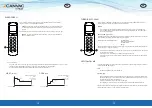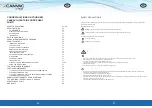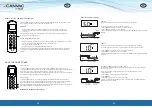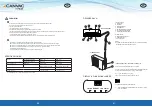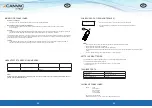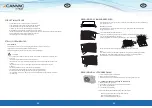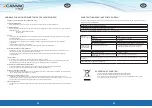
36
37
The following completely normal events can occur during operation.
Compressor protection
On start-up or in the event of a power cut it may take 3–4 minutes for the compressor to start; this is to protect the compressor.
Draught protection
The unit is designed not to blow cold air in HEAT mode when the indoor unit’s heat exchanger is in the following modes and it has not
reached the set temperature:
A) When Heat mode has just started.
B) During defrosting.
Defrosting
•
Frost can form on the outdoor unit during the heating process if the outdoor temperature is low and the relative humidity is high. This
results in a lower heat output from the unit.
•
When defrosting starts the unit will shut off heating and start to defrost automatically.
•
The defrost cycle can last for between 4 and 10 minutes depending on the outdoor temperature and the amount of frost on the outdoor
unit.
•
The indoor unit fan shuts down while the unit defrosts.
•
The period between defrosts varies depending on the outdoor/indoor temperatures and relative humidity.
The indoor unit emits a white mist
•
The indoor unit may emit a white mist in an indoor environment with a high relative humidity. This mist can occur if there is a large
temperature difference between the air intake and air vent in COOL mode.
•
Mist can also occur due to the humidity arising from the defrosting process when air conditioning starts in HEAT mode following the
defrost cycle.
Noise from the unit
•
There may be a low, hissing noise when the compressor is running or has just started.
•
There may also be a clicking noise during defrosting/start-up. This can be because the indoor unit’s heat exchanger is expanding/
shrinking due to rapid changes in temperature, causing stresses in the indoor unit.
The indoor unit emits a particular odour
•
This can be caused by the indoor unit emitting odours it has picked up from building materials, furniture or smoke.
•
This can be because SELF CLEAN mode has not been activated during COOL/DRY operation.
The unit switches to fan mode only
•
When the unit has achieved the desired indoor temperature, the compressor stops automatically and the unit switches to fan mode. The
compressor starts again when the indoor temperature drops below or rises above its setting.
The heat pump is not producing enough heat
•
When the outdoor temperature drops the output of the unit will drop at the same time as the indoor heat demand rises. Adjust the basic
heat source (the house’s electric radiators for example) so that the systems can work together. It should be set to approximately 1–2
degrees below the temperature set on the heat pump. This ensures proper operation/defrosting.
Restart following a power cut
•
When the power is restored following a power cut, the unit restarts automatically restoring all previous settings. This is because the unit
has a memory function.
Symptoms
The unit will not
start.
Cause
Action
Power cut?
Wait until the power is restored.
Has a fuse blown?
Replace the fuse.
Have the remote control batteries run out?
Replace the batteries.
Have you set the timer incorrectly?
Wait or deactivate the timer setting according to the manual.
The room cannot be
adequately cooled/
heated.
Is the temperature setting correct?
Check the settings on the remote control; see the section “The
heat pump is not producing enough heat” on page 18.
The air filter is clogged.
Clean the air filter.
Doors or windows are open.
Close doors and windows.
The air intake/air vent is blocked on the indoor unit/
outdoor unit.
Remove any obstructions and restart the unit.
If the fault has not been remedied contact service. Describe the fault to us and tell us the unit’s model number (found on the indoor unit and
outdoor unit identification plates).
NOTE! Never try to repair the unit yourself.
THE UNIT IS NOT OPERATING AS IT SHOULD
If one of the following faults occurs, shut down the unit immediately, switch off the power and then connect it again. If problems with the following
faults persist contact service.
The OPERATION lamp or another lamp is flashing.
The fuse or residual current device trip.
The remote control is malfunctioning after you have replaced the batteries.
If there is one of the following fault codes in the display: E0, E1, E2, E3... or P0, P1, P2, P3....
NORMAL FUNCTIONS/HEAT PUMP SYMPTOMS
•
The product must be taken to an approved collection point when it is to be scrapped.
•
Batteries (from the remote control for example) are to be taken to an approved collection point.
•
It is prohibited to dispose of refrigerant with household refuse as it could leak out and contaminate
groundwater.
SCRAPPING THE UNIT
EN
EN



